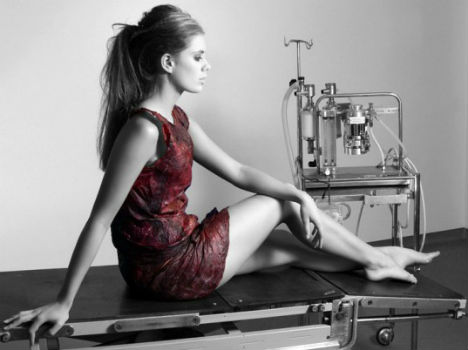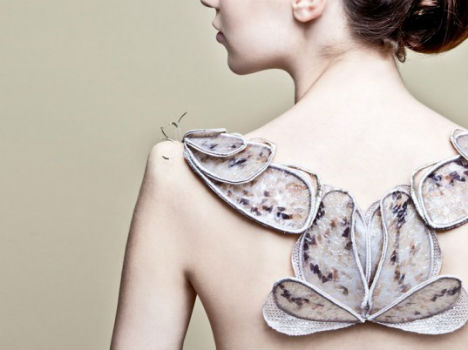Now You Know Lab Grown Biological Textiles
Saturday, 2 February 2019
Edit
Lab Grown Biological Textiles
Introduction
A majority of people give little thought to what their clothes are made of or how they are mad clothes are just worn because it is a social convention. However, if clothing is given a second thought, most people think of cotton, rayon, or spandex, the generic and well known materials. But, recently, there has been a development in the field of textile manufacturing, which makes new fabrics for clothing. Suzanne Lee, a senior researcher in fashion and textiles at Central St. Martins and founder of Bio Couture, makes clothes from bacteria.
Lab-grown biological textiles are new idea of producing textiles in laboratory from cells without using conventional method. Like test tube leather and lab growing meat so no animal would be harmed.
Research By
One of the pioneers in the field, Suzanne Lee, made bio design the core of her business. She started to work on her Bio Couture project ten years ago at Central St. Martins and founder of Bio Couture. Since her first jackets made of leather-like cultivated cellulose, the field has developed new opportunities for advancement. Technology and science have been present in a close relation to fashion for a long time.
Through this new method of textile fabrication, Lee has been able to make several items of clothing successfully.
Production of Biological Textiles
The fabric is created through a basic recipe of a yeast mix that spins cellulose threads when put in contact with green tea and sugar. Once the cellulose is produced, it is pressed into sheets and molded into garments. Although it’s still experimental, this is not a new concept, as non-synthetic fabrics, such as cotton, have to be grown at one stage or another.
One of the pioneers in the field, Suzanne Lee, made bio design the core of her business. She started to work on her Bio Couture project ten years ago at Central St. Martins and founder of Bio Couture. Since her first jackets made of leather-like cultivated cellulose, the field has developed new opportunities for advancement. Technology and science have been present in a close relation to fashion for a long time.
Through this new method of textile fabrication, Lee has been able to make several items of clothing successfully.
 |
| Figure 1: 1st jacket produced from lab grown |
The fabric is created through a basic recipe of a yeast mix that spins cellulose threads when put in contact with green tea and sugar. Once the cellulose is produced, it is pressed into sheets and molded into garments. Although it’s still experimental, this is not a new concept, as non-synthetic fabrics, such as cotton, have to be grown at one stage or another.
Some Other Lab Grown Textiles
Silk-Like Fiber Derived from Spoiled Milk
Few of us would willingly walk around wearing spoiled milk, but it might just become all the rage in the near future. A company called Qmilch makes fabric from protein found in soured ‘secondary milk’ that’s no longer suitable for human consumption, and would normally be thrown away. This zero-waste fabric requires no harmful chemicals to make, and uses less water in the production process than other milk-based fabrics.
Fabric from Fermented Wine
A group of scientists at the University of Western Australia has produced fabric by letting microbes go to work on wine. The scientist’s culture bacteria called Acetobacter in vats of cheap red wine, and the bacteria ferments the alcohol into fibers that float just above the surface. These fibers can be extracted and fashioned into clothing. Acetobacter produce vinegar as its end product, so the garments have a definite odor.
Useable or Not
Clothes made of bacteria grown fabrics is a nifty idea, but it may not be practical for daily use. If Lee and fellow researchers hope to make this marketable, changes would need to be made to make it a durable and trustworthy fabric. This new innovation in textile production does introduce a more environmentally friendly alternative to other materials, especially because the fabric decomposes naturally and quickly compared to other fabrics such as polyester. However, a downside of the bacteria-grown clothing is that, if it gets wet, the fabric disintegrates.
Lee does still own garments made five years ago from the bacteria, which have been maintained in a fairly good condition. The quality of the garments being made from the bacteria grown textile could be improved through the field of Synthetic Biology, but for the meantime, this new development seems only useful for runway fashion, not daily use.
Silk-Like Fiber Derived from Spoiled Milk
Few of us would willingly walk around wearing spoiled milk, but it might just become all the rage in the near future. A company called Qmilch makes fabric from protein found in soured ‘secondary milk’ that’s no longer suitable for human consumption, and would normally be thrown away. This zero-waste fabric requires no harmful chemicals to make, and uses less water in the production process than other milk-based fabrics.
 |
| Figure 2: Spoiled milk fabric |
A group of scientists at the University of Western Australia has produced fabric by letting microbes go to work on wine. The scientist’s culture bacteria called Acetobacter in vats of cheap red wine, and the bacteria ferments the alcohol into fibers that float just above the surface. These fibers can be extracted and fashioned into clothing. Acetobacter produce vinegar as its end product, so the garments have a definite odor.
 |
| Figure 3: Wine fabric |
Clothes made of bacteria grown fabrics is a nifty idea, but it may not be practical for daily use. If Lee and fellow researchers hope to make this marketable, changes would need to be made to make it a durable and trustworthy fabric. This new innovation in textile production does introduce a more environmentally friendly alternative to other materials, especially because the fabric decomposes naturally and quickly compared to other fabrics such as polyester. However, a downside of the bacteria-grown clothing is that, if it gets wet, the fabric disintegrates.
Lee does still own garments made five years ago from the bacteria, which have been maintained in a fairly good condition. The quality of the garments being made from the bacteria grown textile could be improved through the field of Synthetic Biology, but for the meantime, this new development seems only useful for runway fashion, not daily use.
In Fashion Trends
By 2082, couture will be made not from fabric, but from cells. That’s the vision of designer Amy Congdon, whose Biological Atelier project explores how the same sort of medical biotechnology set to revolutionize skin grafts and prosthetics can be carried over into the world of fashion.
As an Eco-Friendly Textile
Considering the social and environmental impact of the textile industry, even the most unlikely sounding ideas deserve a good look and while Biological Atelier is intended for bespoke luxury garments, similar technology could possibly be used on a wider scale. When grown in a lab or made from waste materials rather than farmed, biological-based textiles could potentially replace fabrics made from unsustainable materials, like polyester as long as they don’t require too much chemical manipulation in the process.
By 2082, couture will be made not from fabric, but from cells. That’s the vision of designer Amy Congdon, whose Biological Atelier project explores how the same sort of medical biotechnology set to revolutionize skin grafts and prosthetics can be carried over into the world of fashion.
 |
| Figure 4: Lab grown textile in fashion |
Considering the social and environmental impact of the textile industry, even the most unlikely sounding ideas deserve a good look and while Biological Atelier is intended for bespoke luxury garments, similar technology could possibly be used on a wider scale. When grown in a lab or made from waste materials rather than farmed, biological-based textiles could potentially replace fabrics made from unsustainable materials, like polyester as long as they don’t require too much chemical manipulation in the process.
Some Problem in Biological Textiles
Fabric grown in a soup of green tea, sugar and other nutrients, which bacteria then transform into long cellulose filaments that can be woven once dried. Scientists have also managed to produce a fabric by letting microbes go to work on wine, fermenting the alcohol into fibers. A similar process turns proteins from spoiled milk into fabric. Unfortunately, none of these weird new bio-textiles smell too pretty, but researchers are already working on eliminating that problem.
Image curtsey: www.momtastic.com & www.guhsd.net
Fabric grown in a soup of green tea, sugar and other nutrients, which bacteria then transform into long cellulose filaments that can be woven once dried. Scientists have also managed to produce a fabric by letting microbes go to work on wine, fermenting the alcohol into fibers. A similar process turns proteins from spoiled milk into fabric. Unfortunately, none of these weird new bio-textiles smell too pretty, but researchers are already working on eliminating that problem.
Image curtsey: www.momtastic.com & www.guhsd.net